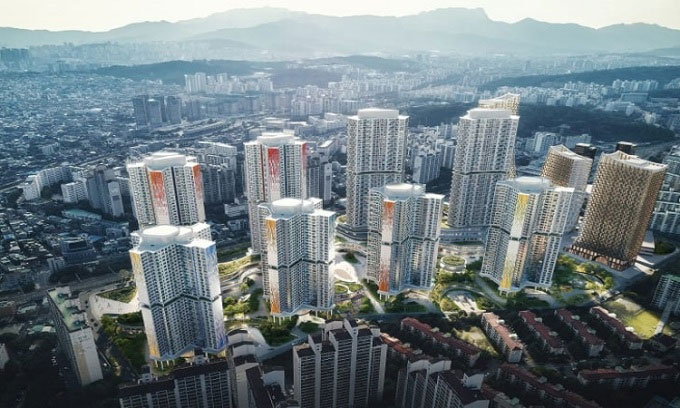Architects are set to build a compact city using modern technology and clean energy, allowing residents to travel anywhere within 10 minutes.
The concept of the “15-Minute City”, where residents can reach their workplace and recreational facilities within a 15-minute walk or bike ride from home, has attracted significant attention from urban planners during the Covid-19 pandemic. Now, a group of architects is planning a more ambitious project in the capital of South Korea, Seoul: the 10-Minute City.

The project includes 8 apartment buildings alongside various commercial and entertainment areas. (Photo: WAX & Virgin Lemon)
Named the “H1 Project”, the development process will transform an old industrial area into an interconnected smart city. Combining 8 apartment buildings with offices and educational spaces, the 50.5-hectare site will also feature amusement parks, sports centers, swimming pools, and urban hydroponic farms.
Designed by the Dutch architectural firm UNStudio with investment from Hyundai Development Company, this will be a car-free compact city. All city amenities will be located within a 10-minute walk from residents’ homes.
Ben van Berkel, co-founder of UNStudio, emphasized that enhancing the daily living experience of residents is the project’s top priority. “We achieve this goal by providing a diverse range of on-site options for people to live, work, and play, thereby helping them save time commuting to other parts of the city,” Berkel stated.
A spokesperson for UNStudio confirmed that the project has received building permits. A series of renderings reveal the neighborhood’s design, featuring gardens, green-roofed buildings, and numerous natural areas connected by pedestrian pathways. The architects noted that clean energy will be produced on-site, and a rainwater collection and storage system will be implemented to reduce water consumption.
The idea of the “15-Minute City” was first proposed by French-Colombian scholar Carlos Moreno in 2016 and gained popularity recently thanks to Paris Mayor Anne Hidalgo during her re-election campaign. Due to the Covid-19 pandemic, people worldwide have increasingly worked from home and limited public transportation, prompting urban planners to focus on designing streets for pedestrians and rethinking how cities manage dense populations.


















































